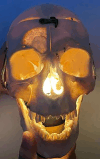A.S.S.E.S.S. for Facial Fillers
- PMID: 39462247
- PMCID: PMC11743322
- DOI: 10.1111/jocd.16633
A.S.S.E.S.S. for Facial Fillers
Abstract
Background: An in-depth and detailed facial assessment is critical in treating and achieving desirable dermal filler and neurotoxin results.
Methods: An acronym called A.S.S.E.S.S. simplifies an often complex and overwhelming amount of data needed to assimilate when performing facial filler and neurotoxin injections. Applying this method to patients in six simple steps provides a starting point and offers a guideline to capture key details for a more comprehensive facial assessment. The A.S.S.E.S.S. acronym stands for animate, shape, side, external, symmetry, and shadows and is helpful in following a methodical approach in analyzing facial shape, profile, and natural facial curves in both static and dynamic states.
Results: Following a regimented A.S.S.E.S.S. approach prior to treating filler and neurotoxin patients allows providers a straightforward guide to achieve a desirable facial shape and profile.
Conclusion: This stepwise facial assessment establishes a logical and detailed approach to ensure the important aspects of facial details are appreciated in creating reliable and pleasing filler and neurotoxin results.
Keywords: aging face; dermal filler; facial assessment; facial profile; facial shape; filler; neuromodulation.
© 2024 The Author(s). Journal of Cosmetic Dermatology published by Wiley Periodicals LLC.
Conflict of interest statement
John P. Fezza: Consultant for Allergan, Evolus, Revance, RVL, Arya Medical. Sheila Barbarino, MD: Speaker Galderma, Merz, SkinCeuticals, Miracu Threads. Julie Woodward: Consultant for Allergan, Galderma, Merz Aesthetics, Prollenium, SkinCeuticals, Horizon. Wendy Lee: Consultant for Allergan, Galderma, Revance, Evolus, Tarsus, RVL, Horizon, Novabay, RoC. Jonathan D. Tijerina, MD, MA: No disclosures. Reed Fezza: No disclosures.
Figures













References
-
- Farkas L. G. and Kolar J. C., “Anthropometries and Art in the Aesthetics of Women's Faces,” Clinics in Plastic Surgery 14, no. 4 (1987): 599–616. - PubMed
-
- Swift A. and Remington K., “BeautiPHIcation™: A Global Approach to Facial Beauty,” Clinics in Plastic Surgery 38, no. 3 (2011): 347–377. - PubMed
-
- Henderson A., “Focusing on Chin Augmentation: Treating the Lower Face Using Dermal Filler,” Journal of Aesthetic Nursing 9 (2020): 191–194.
MeSH terms
Substances
LinkOut - more resources
Full Text Sources
Medical

